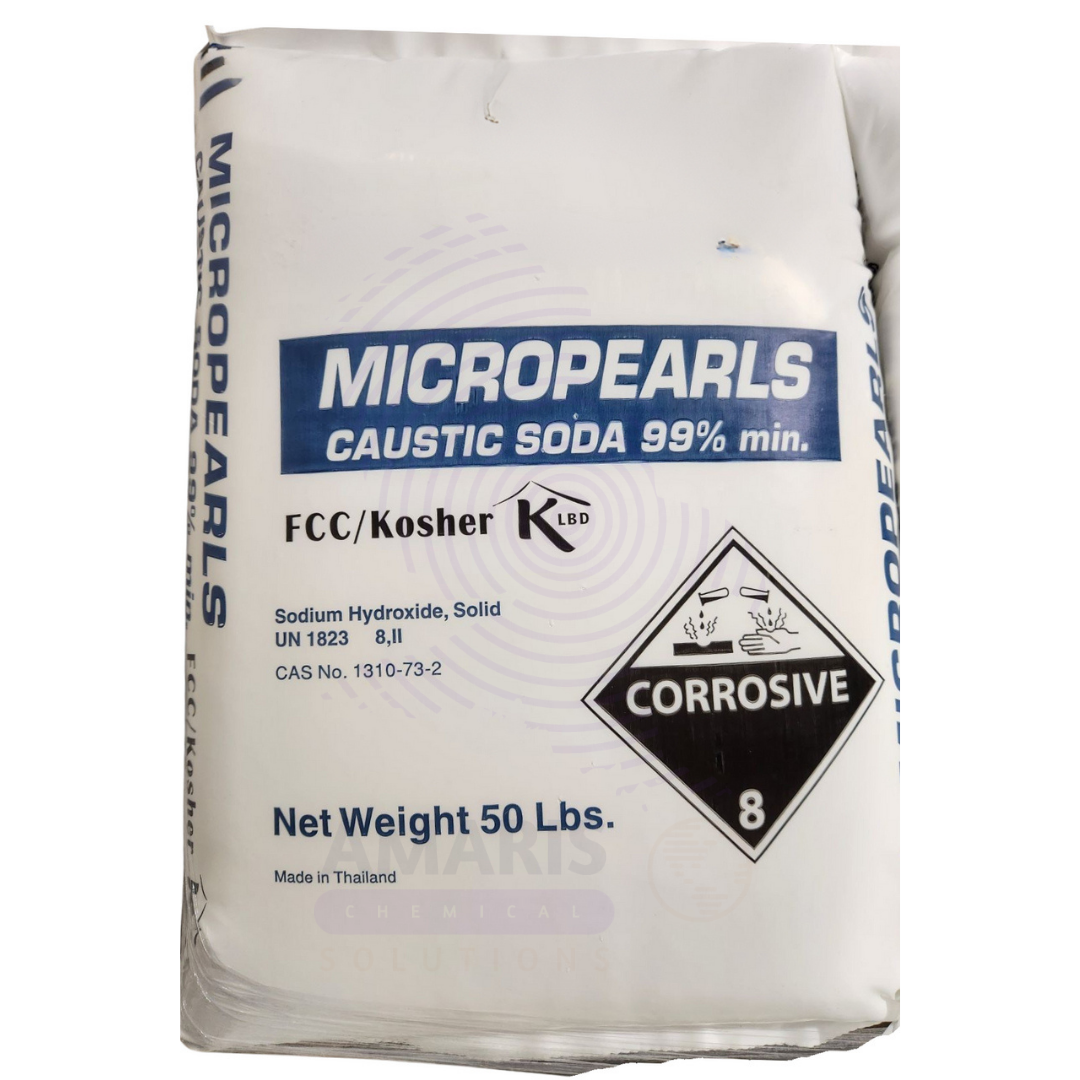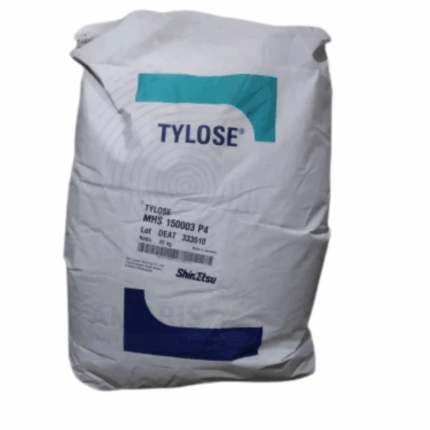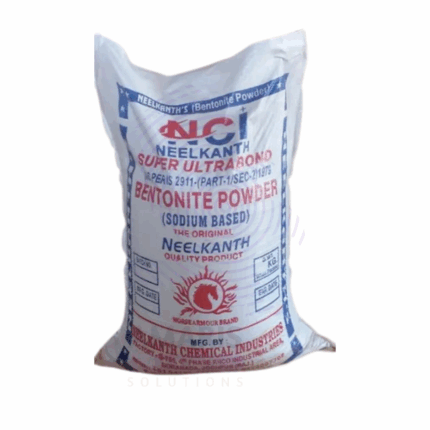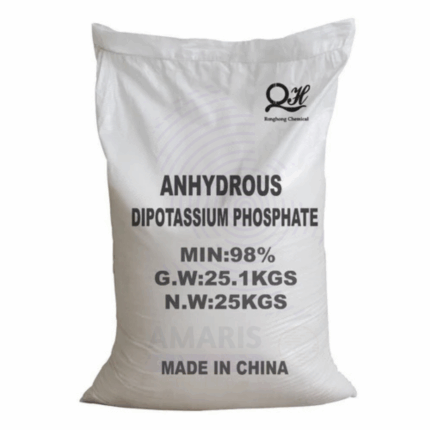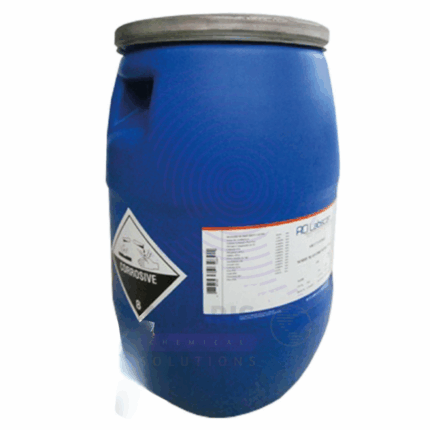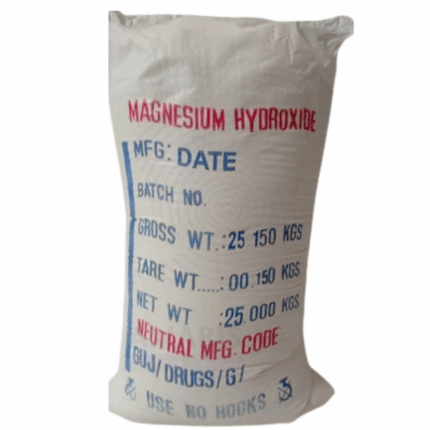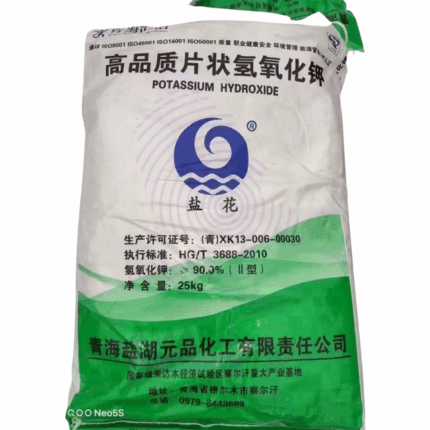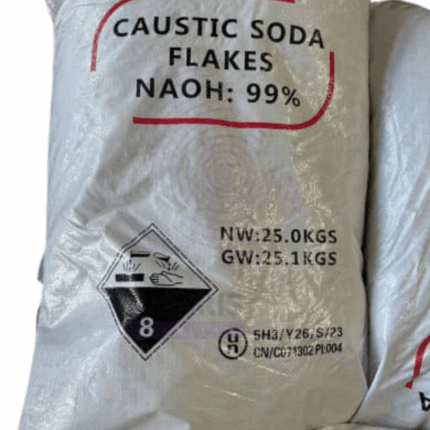
Caustic Soda Micropearls
$ 2.25 Original price was: $ 2.25.$ 2.14Current price is: $ 2.14.
Caustic Soda Micropearls are small, spherical, solid particles of sodium hydroxide (NaOH) produced through specialized prilling or pelletizing techniques. They offer excellent flowability, high purity, and uniform size distribution, making them ideal for precise dosing and handling in industrial and chemical processes. The micropearls form is preferred in applications where dust control, ease of transport, and controlled dissolution rates are critical. Caustic Soda Micropearls exhibit strong alkalinity, are highly soluble in water with an exothermic reaction, and are widely used across many sectors including chemical manufacturing, water treatment, pulp and paper processing, and detergent production.
Caustic Soda Micropearls
Primary Uses
- Chemical Manufacturing
- Used as a strong alkali in producing soaps, detergents, and synthetic fibers.
- Key reactant in chemical synthesis for manufacturing sodium salts, sodium hypochlorite, and other alkali-based chemicals.
- Serves in neutralization and pH control in various chemical processes.
- Pulp & Paper Industry
- Employed in pulping and bleaching to separate lignin from cellulose fibers.
- Used in chemical recovery and processing stages to enhance paper quality.
- Water Treatment
- Utilized for pH adjustment and neutralization of acidic waste streams in municipal and industrial wastewater treatment plants.
- Facilitates removal of heavy metals and neutralization of corrosive elements in water systems.
- Detergent & Cleaning Products
- Integral in the manufacture of detergents, soaps, and cleaning agents due to its ability to saponify fats and oils and neutralize acids.
- Used in drain and oven cleaners for its caustic and degreasing properties.
Secondary Uses
- Food Industry
- Applied as a food-grade alkali (E524) in controlled amounts for peeling fruits and vegetables (such as olives), processing cocoa, and caramel production.
- Functions as a pH regulator and processing aid under strict regulatory conditions.
- Textile Industry
- Used in mercerization of cotton to improve fiber strength, luster, and dye affinity.
- Petroleum Industry
- Involved in neutralizing acidic components during oil refining.
- Aluminum Industry
- Employed in the Bayer process to extract alumina from bauxite ore.
1. Basic Identification Attributes
- Chemical Name (IUPAC): Sodium hydroxide
- Common/Trade Name: Caustic Soda Micropearls
- CAS Number: 1310-73-2
- HS Code: 2815.12.00
- Molecular Formula: NaOH
- Synonyms:
- Sodium Hydroxide Pellets
- Caustic Soda Pellets
- Sodium Hydroxide Microgranules
2. Physical & Chemical Properties
- Physical State: Solid micropearls (spherical pellets)
- Color & Odor: White; odorless
- Melting Point: 318°C (decomposes)
- Boiling Point: Not applicable (decomposes before boiling)
- Density: Approximately 2.13 g/cm³ (solid)
- Solubility:
- Highly soluble in water (exothermic dissolution)
- Insoluble in organic solvents
- pH (1% aqueous solution): Approximately 14 (strongly alkaline)
- Stability: Stable under dry conditions; highly reactive with water and acids
3. Safety & Hazard Attributes
- Hazard Class (GHS): Skin corrosion/irritation (Category 1A)
- NFPA Ratings:
- Health: 3
- Flammability: 0
- Reactivity: 1
- Exposure Limits: OSHA PEL: 2 mg/m³ (ceiling)
- Toxicity: Corrosive; causes severe chemical burns on contact
- Reactivity: Vigorous reaction with acids, water, and some metals
4. Storage & Handling Attributes
- Storage Conditions: Store in cool, dry, well-ventilated areas away from moisture and incompatible materials.
- Container Type: Polyethylene drums, coated steel drums, or other corrosion-resistant containers.
- Shelf Life: Indefinite when stored properly in sealed, dry conditions.
- Special Handling: Use full protective equipment; avoid dust inhalation and skin or eye contact.
5. Regulatory & Compliance Attributes
- FDA Status: Approved as a food additive (E524) under controlled use conditions.
- REACH Status: Registered chemical.
- Transportation: Classified as hazardous material (UN1823 or UN1824 depending on packaging).
- Waste Disposal: Dispose of following hazardous waste regulations; neutralize prior to disposal.
6. Environmental & Health Impact
- Ecotoxicity: Toxic to aquatic organisms due to high pH; requires neutralization before release.
- Persistence: Does not bioaccumulate; neutralizes rapidly in the environment.
- Bioaccumulation: Not applicable.
- Carcinogenicity/Mutagenicity: Not classified as carcinogenic or mutagenic.
- Biodegradability: Inorganic chemical; not biodegradable but neutralizes in environment.
Safety Handling Precautions
Personal Protective Equipment (PPE):
- Chemical-resistant gloves (neoprene, nitrile)
- Protective goggles or face shield
- Long-sleeved protective clothing
- Respirator for dust exposure
Handling Measures:
- Avoid inhalation of dust and contact with skin and eyes
- Use in well-ventilated environments
- Prevent moisture contact to avoid caking and exothermic reactions
Storage Measures:
- Keep containers tightly sealed
- Store away from moisture and incompatible substances
- Use spill containment measures
Hygiene Practices:
- Wash hands thoroughly after handling
- No eating, drinking, or smoking in storage or handling areas
First Aid Measures
- Inhalation: Move affected person to fresh air; seek medical attention if irritation persists.
- Skin Contact: Rinse immediately with plenty of water for at least 15 minutes; remove contaminated clothing; seek medical care.
- Eye Contact: Flush eyes with water continuously for 15 minutes; obtain immediate medical assistance.
- Ingestion: Do not induce vomiting; rinse mouth and seek urgent medical attention.
Firefighting Measures
- Fire Hazards: Not flammable but reacts violently with water and acids producing heat.
- Extinguishing Media: Use dry chemical, foam, or CO₂ on surrounding fires; avoid direct water contact.
- Special Precautions: Firefighters must wear full protective gear and breathing apparatus.
- Decomposition Products: May release toxic fumes such as sodium oxides and hydrogen gas on decomposition.


 Preservatives(food)
Preservatives(food) Flavor Enhancers
Flavor Enhancers Acidulants
Acidulants Sweeteners
Sweeteners Antioxidants
Antioxidants Colorants(food)
Colorants(food) Nutraceutical Ingredients (food)
Nutraceutical Ingredients (food) Nutrient Supplements
Nutrient Supplements Emulsifiers
Emulsifiers
 Collectors
Collectors Dust Suppressants
Dust Suppressants Explosives and Blasting Agents
Explosives and Blasting Agents Flocculants and Coagulants
Flocculants and Coagulants Frothers
Frothers Leaching Agents
Leaching Agents pH Modifiers
pH Modifiers Precious Metal Extraction Agents
Precious Metal Extraction Agents
 Antioxidants(plastic)
Antioxidants(plastic) Colorants (Pigments, Dyes)
Colorants (Pigments, Dyes) Fillers and Reinforcements
Fillers and Reinforcements Flame Retardants
Flame Retardants Monomers
Monomers Plasticizers
Plasticizers Polymerization Initiators
Polymerization Initiators Stabilizers (UV, Heat)
Stabilizers (UV, Heat)
 Antifoaming Agents
Antifoaming Agents Chelating Agents
Chelating Agents Coagulants and Flocculants
Coagulants and Flocculants Corrosion Inhibitors
Corrosion Inhibitors Disinfectants and Biocides
Disinfectants and Biocides Oxidizing Agents
Oxidizing Agents pH Adjusters
pH Adjusters Scale Inhibitors( water)
Scale Inhibitors( water)
 Antioxidants(cosmetic)
Antioxidants(cosmetic) Emollients
Emollients Fragrances and Essential Oils
Fragrances and Essential Oils Humectants
Humectants Preservatives
Preservatives Surfactants(cosmetic)
Surfactants(cosmetic) Thickeners
Thickeners UV Filters
UV Filters
 Fertilizers
Fertilizers Soil Conditioners
Soil Conditioners Plant Growth Regulators
Plant Growth Regulators Animal Feed Additives
Animal Feed Additives Biostimulants
Biostimulants Pesticides (Herbicides, Insecticides, Fungicides)
Pesticides (Herbicides, Insecticides, Fungicides)
 Active Pharmaceutical Ingredients (APIs)
Active Pharmaceutical Ingredients (APIs) Excipients
Excipients Solvents(pharmaceutical)
Solvents(pharmaceutical) Antibiotics
Antibiotics Antiseptics and Disinfectants
Antiseptics and Disinfectants Vaccine Adjuvants
Vaccine Adjuvants Nutraceutical Ingredients (pharmaceutical)
Nutraceutical Ingredients (pharmaceutical) Analgesics & Antipyretics
Analgesics & Antipyretics
 Analytical Reagents
Analytical Reagents Solvents(lab)
Solvents(lab) Chromatography Chemicals
Chromatography Chemicals Spectroscopy Reagents
Spectroscopy Reagents microbiology-and-cell-culture-reagents
microbiology-and-cell-culture-reagents Molecular Biology Reagents
Molecular Biology Reagents Biochemical Reagents
Biochemical Reagents Inorganic and Organic Standards
Inorganic and Organic Standards Laboratory Safety Chemicals
Laboratory Safety Chemicals Specialty Laboratory Chemicals(Special Laboratory Equipment)
Specialty Laboratory Chemicals(Special Laboratory Equipment)
 Demulsifiers
Demulsifiers Hydraulic Fracturing Fluids
Hydraulic Fracturing Fluids Scale Inhibitors(oil)
Scale Inhibitors(oil) Surfactants(oil)
Surfactants(oil) Drilling Fluids
Drilling Fluids
 Dyes and Pigments
Dyes and Pigments Bleaching Agents
Bleaching Agents Softening Agents
Softening Agents Finishing Agents
Finishing Agents Antistatic Agents
Antistatic Agents
 Admixtures
Admixtures Waterproofing Agents
Waterproofing Agents Sealants and Adhesives
Sealants and Adhesives Curing Compounds
Curing Compounds Concrete Repair Chemicals
Concrete Repair Chemicals Anti-Corrosion Coatings
Anti-Corrosion Coatings
 Surfactants(cleaning)
Surfactants(cleaning) Builders
Builders Enzymes
Enzymes Solvents (Cleaning)
Solvents (Cleaning) Fragrances
Fragrances
 Electronic Chemicals
Electronic Chemicals Catalysts
Catalysts Lubricants
Lubricants Photographic Chemicals
Photographic Chemicals Refrigerants
Refrigerants Automotive chemicals
Automotive chemicals Pyrotechnic Chemicals
Pyrotechnic Chemicals
 Biodegradable Surfactants
Biodegradable Surfactants Bio-based Solvents
Bio-based Solvents Renewable Polymers
Renewable Polymers Carbon Capture Chemicals
Carbon Capture Chemicals Wastewater Treatment Chemicals
Wastewater Treatment Chemicals
 Pigments
Pigments Solvents(paint)
Solvents(paint) Specialty Coatings
Specialty Coatings Binders/Resins
Binders/Resins Additives
Additives Driers
Driers Anti-Corrosion Agents
Anti-Corrosion Agents Functional Coatings
Functional Coatings Application-Specific Coatings
Application-Specific Coatings
 Fresh Herbs
Fresh Herbs Ground Spices
Ground Spices Whole Spices
Whole Spices Spice Blends
Spice Blends Dried Herbs
Dried Herbs
 Leavening Agents
Leavening Agents Dough Conditioners
Dough Conditioners Flour Treatments
Flour Treatments Fat Replacers
Fat Replacers Decoratives
Decoratives Preservatives(baking)
Preservatives(baking)
 Plasticizers & Softeners
Plasticizers & Softeners Reinforcing Agents
Reinforcing Agents Adhesion Promoters
Adhesion Promoters Vulcanizing Agents
Vulcanizing Agents Antidegradants
Antidegradants Blowing Agents
Blowing Agents Fillers & Extenders
Fillers & Extenders Accelerators & Retarders
Accelerators & Retarders